Remember that movie King of Kong with the rival Donkey Kong guys and the wizened man in the referee outfit who logged all their high scores? Well, it looks like there’s an online version of Twin Galaxies now where they have an “International Scoreboard,” which includes… Atari Lynx games! I’ve emailed them regarding my score for Super Missile Command as it should top their list (I beat the current high score by over 33,000 points) but I haven’t heard back. In the meantime, in an attempt to bring readers to this site, and to help you become a serious contender with an outdated, notoriously unloved system, I will begin my reviews with the final Lynx game Atari ever produced (these days, you can find it for around 40 or 50 bucks on eBay). After this release, Atari only produced games for other systems, abandoning the poor cumbersome Lynx forever.
Super Asteroids also comes bundled on this same game card, but it’s horribly dull, and it’s missing the crucial vector graphics and hypnotic electronic heartbeat of the arcade favorite. So we’ll just stick with Super Missile Command, a solid, addictive update of the arcade classic. You remember the bowling-ball sized trackball and the bright red, seizure-inducing “The End” covering the screen when the missiles finally overwhelmed you? Yeah, none of that is here. But it’s still worthwhile.
Okay, the first thing you need to know is the early levels are actually harder than the intermediate levels. But after that, of course, just like the arcade version, it gets impossible. The reason the beginning three levels are so difficult is because you haven’t upgraded your missiles yet. This is one of several updates to this handheld version that must help earn that “Super” distinction in the title. Once this upgrade happens, it’s like the Goldilocks porridge that’s just right, and the game is at its most entertaining and playable. As your points accumulate, you can buy more weapons in a weapon shop interlude (not to be confused with The Weapon Shops of Isher by A. E. van Vogt, as this one doesn’t teach us any moral lessons).
But until you can upgrade your main missiles, they are painfully slow, much much slower than they were in the arcade. This means leading the targets a good centimeter before firing (a centimeter on this small screen is approximately 17,000 miles of airspace). But the real problem is that once you learn to do this efficiently, you have to unlearn it just as fast because the missiles you’re going to consistently restock for the remainder of the game are of the “Laser Launched” variety, and those hit the target about ten times quicker. These are utterly essential when the screen fills up with targets after level 5. So here’s my breakdown of the weapons available and what they do (or in one case, what they were supposed to do).
p.s. The cost of these weapons is depicted in British pounds, bizarrely enough. I’ve found no reason for this in my research.
Game Play
The terrain of this version differs slightly from its arcade ancestor. Although the layout and objectives are similar with a moon-like surface (perpetual night! spooky!) and six cities and three missile bases to protect, which regenerate after each wave (so it’s a good tactic to abandon the bases that are furthest from your remaining cities as the game goes on), you cannot, however, chose which base will fire (the arcade version had “Alpha,” “Delta,” and “Omega” bases and corresponding buttons). So it’s more like an automatic transmission than a stick shift. But don’t worry, the game always chooses the nearest base to launch from, so this isn’t really an issue.
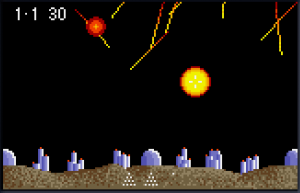
If we can just hold on until the morning, troops, I’m sure the missiles will stop! [perpetual night]
Primary Weapons
Fast: These missiles are indeed faster than the ones you start with, but so is an Amish traffic jam. There is no need to buy these.
Megaton: These missiles produce a larger explosion, but they are as almost as slow as the starter missiles. There is no need to buy these.
Dual: These missiles produce two small explosions, the equivalent of the Megaton explosion but a bit more horizontal. This is perhaps more handy with larger groups of enemy missile, but because they are nearly as slow as the starter missiles, you guessed it, there is no need to buy these.
Cluster: Finally something worth that crazy British fish-and-chips currency! These are similar to the Dual missiles, except that they simulate approximately four small explosions in a long, oblong pattern. Think of the famous witness descriptions of “cigar-shaped” UFOs in the ’60s. This is the burst they deliver, and this is very helpful for strings of missiles or for destroying all enemies as soon as they appear on screen at the top of the screen (more about this in the Strategy section).
Seek: I would very much love to tell you what these missiles do. I would rather do nothing else except explain the purpose of this mysterious game feature. The suspense you’re feeling is real. But we will never know. These missiles are around the same price as the Cluster missiles, and the little graphic in the weapon shop has their fuselage twisted and curving much like Lamar’s javelin in Revenge of the Nerds, so I can only assume that they somehow change trajectory to home in on targets? The problem is that they do not do this. They don’t do anything like this. They don’t seek. They don’t twist. They don’t win the annual Greek Games with their “limp-wristed aerodynamics.” In fact, I’ve stopped writing this review at this moment to try them out one more time… and they still react exactly like the Megaton missiles. It looks like the Atari programmers forgot to finish this aspect of the game. Consequently, there is no need to buy these unless your life is perfect and without frustrations (actually I think they target the Blasters).
Laser Launched: Now we’re talking. These zip across the sky faster than any other weapon, and they produce the large Megaton-level explosion. The speed and size of the explosion means that they can also be used much closer to the cities you’re trying to protect, as they actually appear to engulf them (although they only eliminate the target and not your populace, like a neutron bomb! I mean, the opposite of a neutron bomb. What? Agree to disagree). So these are definitely essential during large assaults. Which is why I would recommend you ignore the other weapon selections and use these missiles exclusively once they become available after level three.
Experimental: Available in later levels of the game, this is an entertaining option, as it simply cycles through all weapons randomly. This feature serves no useful purpose, however, besides adding mystery to your attack. It’s sort of like being The Mask for a day, but with no idea whether you’ll pull a balloon animal or a bazooka from your pocket. Try it once just to satisfy your curiosity.
Secondary Weapons
These are accessed by toggling Option 1 and then fired by pressing the B button. You are allowed to stockpile what I’m calling “secondary weapons” in addition to your primary weapons at any time, but these are typically in low supply, usually used as a last resort, and more expensive than the primary weapons. All are lovely to look at, but once you’ve exhausted your supply of regular missiles and turned to your secondary weapons for help, your sky is likely overwhelmed and nearing the end of your game, with a few exceptions detailed below:
Remote: When you fire one of these weapons, you don’t really fire anything. You actually leave a blinking cursor on the screen where you want the explosion to occur. Basically, you’re anticipating where a missile will pass by, and once it does pass over this marked area, the nearest missile base automatically fires to destroy it. I can’t think of a more useless feature (except maybe the Lambda Lambda Lambda javelins mentioned earlier), and there’s certainly no time for guesswork like this in such a serious situation. Come on. Do they think we’re playing games here? Not recommended.
Rain: This weapon produces a fireworks display that in turn detonates into a series of Megaton-level explosions. The delay of the explosion makes it effective for shielded enemies (more on that later).
Star: This weapon is similar to the Rain fireworks display, but the explosion is even larger, covering almost a third of the screen (which on the Lynx is an area as vast and impressive as nine Boston album covers). Very effective for large groups of missiles and shielded enemies.
Shield: This defensive weapon is unique in that it produces a small half-circle anywhere in the sky to stop attackers. This shield lasts less than ten seconds, but if you’ve become overwhelmed, it can stop a concentrated effort of missiles and enemies on one side of the screen when you work the other. Or, even more importantly, it can protect your last remaining city while you focus the majority of your energies on clearing the sky. It’s also a surprisingly effective offensive weapon against the dreaded saucers (more on that later).
Armageddon: This weapon covers the screen in an explosion similar to the game-ending graphic in the arcade (but circular rather than that strange octagon). It destroys everything on the screen except your cities, and is essential in desperate situations. It’s also fun to use. Its name is a bit of false advertising though, as the Moon does not turn to blood.
p.s. Armageddon be damned, and despite Twin Galaxies refusal to acknowledge it so far, I achieved another World Record while writing this review. I’m no mathemagician, and I lost my abacus, but my score down there in that picture has got to be more than this score.
(update: those slippery fuckers at Twin Galaxies have buried their Lynx scores behind a veil of logins and fees, so you’ll have to trust me that my score on the screen below is 33,000 plus points more than their, er, “champion,” and that I also routinely reach 70,000-plus points and have the bronzed thumbs to prove it)
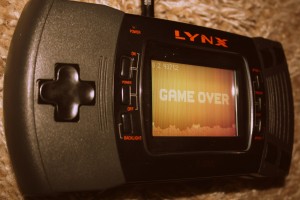
See all those dots still underground? No? That’s because none of my missiles are still in their silos. Humans won’t turn the key, eh? Dabney Coleman from WarGames was wrong.
Enemies
ICBM: Enemy missiles that descend from the sky fairly relentlessly. They are easily dealt with and their pathways anticipated because of their exhaust trails, but they become a problem when other enemy attackers distract you from their assault. Also beware a second ICBM lagging behind a first, disguised when it follows along in the exact same trajectory.
Plane: These bombers show up early on, but they are among the most dangerous enemies simply because you have to destroy them before they travel halfway across the screen. If you don’t and they release their payload, the resulting bomb is extremely difficult to destroy, even with Laser Launched missiles. This bomb will almost always destroy a city or missile base.
Satellite: As slow-moving as the Plane, the Satellite at first glance seems more dangerous because of the Bomb/MIRVs they release. Not true. See below.
Bomb/MIRV: This is a slower version of the Plane payload, which typically bursts into two or three separate ICBMs. Although they will spring into existence much closer to your cities, they are as slow as regular ICBMs and easy to eliminate.
Blaster: These spacecraft are elusive and dangerous. They will avoid any missile of yours that is not a direct hit (which is no mean feat), unless you’re using the slower “Seek” missiles, which aren’t really worth the hassle. And if the Blasters get down to your cities, much like the saucers in Independence Day, they will release a beam of lethal energy into the naïve/suicidal welcoming party on the top of the skyscraper and turn your city into a mushroom cloud. Also, the time you spend trying to score a direct hit on these Blasters, or the time wasted screwing around with the sluggish, Blaster-eliminating Seek missiles, will leave you vulnerable to the slow-moving ICBMs, as well. A recommended stalling tactic is to distribute shields above your cities, or to force the Blasters off the screen with a barrage of explosions. They will avoid these bursts and fly higher, but they will keep returning as long as the missile assault continues. But as with all levels, the siege is over once the ICBMs cease. Therefore, after this, just like the Planes and Satellites, the Blasters will wander away like lost chickens.
Saucer: The worst of the enemy combatants. The Saucer is a large, shielded ship, which will succumb to two well-timed Laser Launched missile strikes, or three rapid weapon strikes of any type, as its shield is fully depleted after any sustained, five-second barrage. But defeating it is harder than it sounds because there’s a bit of a catch. Typically, your weapon has to fully detonate and disperse around the Saucer before you fire another. If you don’t and just continue to pump overlapping missile explosions into the Saucer, it will usually treat these bursts as just one missile. This means you spend a lot of time dealing with the Saucer while other attacks continue. And unlike the Blaster, which can be pushed off the screen or stopped with shields, the Saucer ignores your shields and panicked bursts and only has one objective on its alien mind – to suck your city up into the clouds Skyline-style (more like the ship-capture tractor beams in Galaga actually). Its M.O. is to position itself directly over a city, after which a thin, red beam appears from the bottom of the saucer. This red beam swells until it engulfs the buildings (or triangle, or silly bulbous mess). Now, once the beam has swelled, the Saucer is vulnerable for approximately one second (more Independence Day inspiration?), but usually your city is drawn up into the sky and into this beam of light and then carried away. Three weapons are best utilized against this dastardly foe. One, the Star missiles, as already noted. Next up would be the Rain missiles, which have the delayed burst, which means striking the Saucer two extra blows in one shot and pretty much destroying it every time. And then number three, the Shield, which you can conjure up over top of a Saucer. Just placing a shield over a Saucer serves as a constant attack, even as it sits, and eventually the Saucer will detonate. Furthermore, this shield that remains hovering near the top of the screen will also help against ICBMs so you can concentrate defenses elsewhere.
One more thing to consider when dealing with a Saucer is the fact that the process of lifting your city into the air is surprisingly slow (well, cities are heavy), so this gives you plenty of time to finish off the metropolis-abducting culprit if you choose. However, if you destroy it once the tractor beam has moved your city even one pixel up into the sky, unlike Galaga, you do not retrieve it. The captured city explodes along with the Saucer. So, since you’ve lost the city regardless, it’s a good idea to destroy the Saucer as it leaves, not just for spiteful satisfaction, but because who knows where they were taking the thing. Perhaps the population was being relocated to a peaceful planet. Perhaps your people would have spent their remaining lives in horrible experiments. You’ll never know. It’s best not to take any chances. Shoot it down.
Now that you’ve been familiarized with all aspects of the game, below is the definitive guide to your very own high score.
Strategy
Move your cursor back and forth across the top of the screen and deplete your weapons in a steady stream. Repeat.

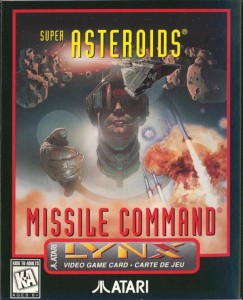
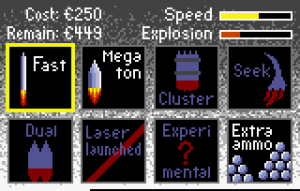
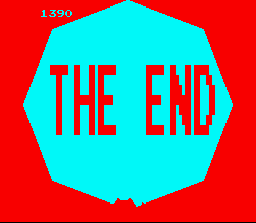
is there an ending to this game? the manual is kind of ambiguous about it…
good question. I’ve never gotten past Level 9, but I’ve heard that, just like the arcade version, there is no killscreen and it goes on and on until your cities are destroyed.